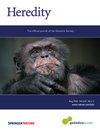Five millennia of mitonuclear discordance in Atlantic bluefin tuna identified using ancient DNA
IF 3.9
2区 生物学
Q2 ECOLOGY
引用次数: 0
Abstract
Mitonuclear discordance between species is readily documented in marine fishes. Such discordance may either be the result of past natural phenomena or the result of recent introgression from previously seperated species after shifts in their spatial distributions. Using ancient DNA spanning five millennia, we here investigate the long-term presence of Pacific bluefin tuna (Thunnus orientalis) and albacore (Thunnus alalunga) -like mitochondrial (MT) genomes in Atlantic bluefin tuna (Thunnus thynnus), a species with extensive exploitation history and observed shifts in abundance and age structure. Comparing ancient (n = 130) and modern (n = 78) Atlantic bluefin MT genomes from most of its range, we detect no significant spatial or temporal population structure, which implies ongoing gene flow between populations and large effective population sizes over millennia. Moreover, we identify discordant MT haplotypes in ancient specimens up to 5000 years old and find that the frequency of these haplotypes has remained similar through time. We therefore conclude that MT discordance in the Atlantic bluefin tuna is not driven by recent introgression. Our observations provide oldest example of directly observed MT discordance in the marine environment, highlighting the utility of ancient DNA to obtain insights in the long-term persistence of such phenomena.

使用古代DNA鉴定大西洋蓝鳍金枪鱼中5000年的核分裂不一致。
物种间的有丝核不一致性在海洋鱼类中很容易被记录下来。这种不协调可能是过去自然现象的结果,也可能是以前分离的物种在空间分布发生变化后最近渗入的结果。利用跨越5000年的古代DNA,我们研究了大西洋蓝鳍金枪鱼(Thunnus thynnus)中太平洋蓝鳍金枪鱼(Thunnus orientalis)和长鳍金枪鱼(Thunnus alalunga)类线粒体(MT)基因组的长期存在,大西洋蓝鳍金枪鱼(Thunnus thynnus)具有广泛的开发历史,并观察到丰度和年龄结构的变化。通过比较古代(n = 130)和现代(n = 78)大西洋蓝鳍金枪鱼MT基因组,我们没有发现显著的时空种群结构,这意味着种群之间持续的基因流动和数千年来的有效种群规模。此外,我们在5000年前的古代标本中发现了不一致的MT单倍型,并发现这些单倍型的频率随着时间的推移保持相似。因此,我们得出结论,大西洋蓝鳍金枪鱼的MT不一致不是由最近的渗入造成的。我们的观察提供了在海洋环境中直接观察到的MT不一致的最古老的例子,突出了古代DNA的效用,以获得对这种现象的长期持久性的见解。
本文章由计算机程序翻译,如有差异,请以英文原文为准。
求助全文
约1分钟内获得全文
求助全文
来源期刊

Heredity
生物-进化生物学
CiteScore
7.50
自引率
2.60%
发文量
84
审稿时长
4-8 weeks
期刊介绍:
Heredity is the official journal of the Genetics Society. It covers a broad range of topics within the field of genetics and therefore papers must address conceptual or applied issues of interest to the journal''s wide readership
 求助内容:
求助内容: 应助结果提醒方式:
应助结果提醒方式:


